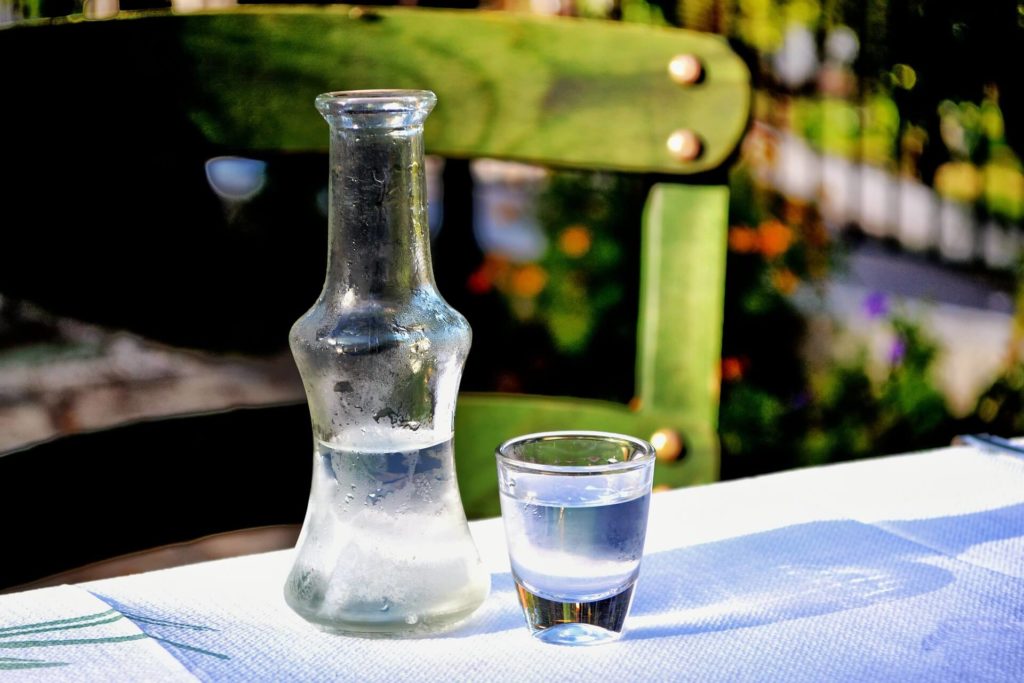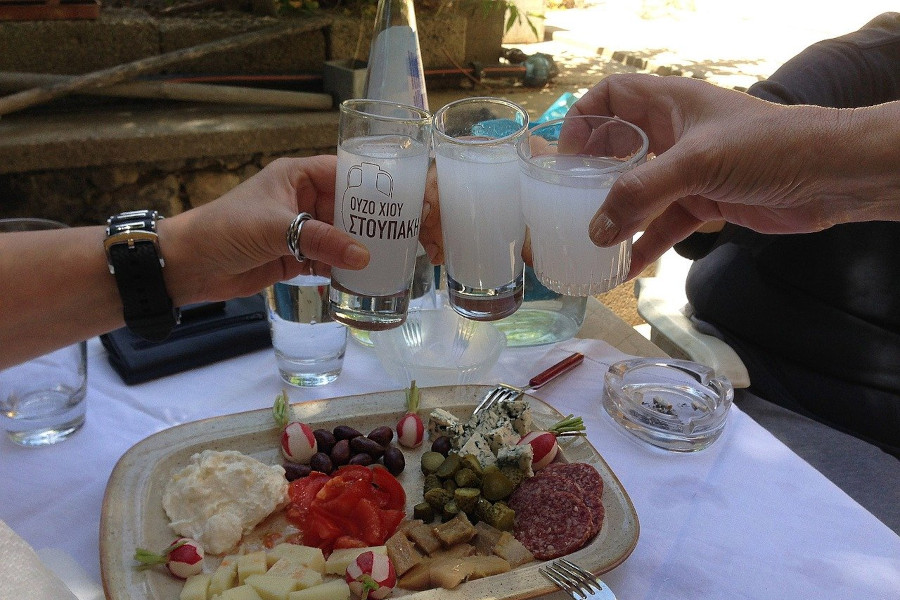START BOOKING YOUR TRIP TO Greece
** Please note that we get a small commission if you book via our referral links. We use this to invest in new foodie content and to update the Greece Foodies website.
Cretan Spirits: Raki vs Ouzo
Local greek spirits – every country has its own, notably Raki and Ouzo. In Germany, this is Schnapps, in America, it’s bourbon; and in Italy, it’s Grappa. So, when it comes to great Greek national liquors, there’s only one possible choice; Ouzo.
Or is there?
Thanks to its geographic position, Raki has become another popular tipple in the country, influenced by its neighboring countries. It’s the national drink of nearby Albania, Turkey, and Bulgaria, each with its own variation. And, of course, not forgetting the Greek island of Crete, where Raki, which goes by the moniker ‘Tsikoudhia.’
Raki vs Ouzo!! Let’s find out more about each of these punchy liquors.
What is Raki?

Raki is an extremely potent spirit, usually 90% proof, and is a ‘brandy’ made from grapes. Greek raki is typically between 40% and 45% alcohol by volume, making it one of the strongest alcoholic beverages available.
It typically derives from grape pulp skin – however, some countries have been known to use raisins and figs too. Sure, it’s noted for its distinctive taste from the anise flavoring, some say very similar to Ouzo and Pastis.
The raki distillation process typically involves two steps. First, the grape musts are distilled in order to produce a clear liquid known as “raki base.” This raki base is then redistilled with aniseeds, which give raki its characteristic flavor. Raki is often served with Meze, a selection of small dishes that are traditionally eaten before a meal. It can also be enjoyed on its own or with mixer such as water or soda water.
>> Read: Traditional Cretan Products
Widely consumed throughout the year, Raki is often presented as a digestif after eating. Unless you’re a seasoned Raki aficionado, the clear liquid is mixed with water to create a milky consistency – in Turkey they call it ‘Lions milk’!
Due to its high potency, Raki (mixed with water) is enjoyed slowly with small steady sips.
For fans of the drink, the World Raki Festival takes place in December in Adana, Turkey.
>> Read: Traditional Cretan Recipes
What is Ouzo?

Indeed, the most famous Greek beverage outside of a Greek coffee, Greek ouzo is synonymous with a trip to Greece. Most of us have bought tiny souvenir bottles home as a keepsake, or gifts for family and friends – others have been brave enough to try it first-hand!
Yes, Ouzo has a long tradition that dates back to the 14th century. Although it wasn’t until the turn of the 1900s, that it became distilled into the drink we know it today. It was first made in Tyrnavos in Thessaly.
Produced in copper stills, the alcohol is mixed with water and aniseed as well as popular Greek spices, to create its famous taste.
🍷Grab your bottle of Greek ouzo now and bring home the taste of the Mediterranean! We offer 10% off entire order!!!
Typically, around 35-45% proof (sometimes stronger). Ouzo is a strong alcoholic beverage that is best enjoyed watered down – especially for beginners. Although it can be sipped straight (as many Greeks do), it is o to add some water to dilute the spirit, until it becomes cloudy white. If you’re a fan of aniseed flavor, this has the unmistakable tones of black licorice. It’s a taste that can take some getting used to for novices.
Ouzo tends to be a summertime drink, quaffed slowly alongside mezze (Greek tapas) and fish dishes. For those with a taste for it, there are some famous ‘Ouzeries’ to sample across the country. There are more than 300 different types of produces to look out for, including; Barbagiannis, Mini Mytilinis, and Tsantali.

Food Tour in Chania
Looking to add a little flavor to your trip to Greece? Then come join us on one of our walking food tours through the city of Chania!
Origins
The beautiful island of Lesvos (Mytilini) is the main hub of commercial ouzo production. It accounts for at least half the country’s exports – from a whopping 17 different distilleries.
There are various distillers in Crete dedicated to the output of Raki. This includes the famous Kedria golden distillery. To learn more about the great flavors of Crete, including its Greek Mezes, book a private food and wine tour.
What’s the main difference between Raki and Ouzo?
From the above, it’s easy to mistake the two Mediterranean liquors. However, there are some key differences when it comes to raki vs ouzo.
First of all, Ouzo is a drink that hails from Greece, while Raki has its origins in Turkey.
Yes, the distillation process for both is similar, using pulp grape to produce a distinct aniseed flavor. But, the alcoholic volumes differ.
The main difference is that Raki tends to be much, much stronger than Ouzo. It is often 90% proof, nearly twice that of Ouzo. And if you can’t see it, you can certainly taste the difference!
If you want to know more about local spirits, check out our Greek Spirits blog.
Greek Drinking Culture and Traditions
Both ouzo and raki hold significant cultural value in Greece and their consumption is often accompanied by social traditions and customs.
Ouzo is typically enjoyed as an aperitif before meals, usually accompanied by meze (small dishes). It is traditionally served chilled and neat, but some prefer it with a splash of water or ice. Ouzo is also commonly enjoyed at social gatherings and celebrations and is often referred to as the “national drink” of Greece.
Raki, on the other hand, is typically consumed after a meal as a digestif. It is often served with meze, fruits, or desserts, and is traditionally drunk neat at room temperature. Raki is also known for its social significance in Greek culture, where it is commonly consumed during celebratory occasions and gatherings with friends and family.
In Greece, the consumption of ouzo and raki is often accompanied by various customs and traditions. For example, it is customary in Greece to clink glasses and say “stin igia mas” (to our health) before taking a sip of ouzo.
Overall, both ouzo and raki hold a special place in the drinking culture and traditions of their respective countries, and provide a unique experience for those looking to explore the local culture through their culinary and drinking traditions.
How to best enjoy a glass of Raki or Ouzo?
There are two ways to drink Raki or Ouzo. The first is to sip it slowly, savoring the strong flavor of the spirit. The second is to drink it quickly, chasing it with a bite to eat. Both methods have their merits, and it really depends on your personal preference.
If you want to savor the flavor of Raki or Ouzo, then take your time sipping it. Let the spirit linger on your tongue, and enjoy the way it warms your throat as you swallow. You can also add a bit of water to dilute the alcohol and make the flavor more pronounced. Just be warned that sipping Raki or Ouzo can lead to a strong buzz!
Food Pairings Raki vs Ouzo
Ouzo and raki are often enjoyed alongside traditional Greek dishes, and pairing the right food with each spirit can enhance the overall experience. When it comes to food pairings, there are some notable differences between ouzo and raki.
Ouzo is commonly paired with a variety of mezedes, or small plates. These dishes are typically salty or spicy, as the aniseed flavor in ouzo can be quite strong. Popular mezedes that pair well with ouzo include grilled octopus, feta cheese, olives, sardines, and dolmades. Ouzo is also a great accompaniment to seafood dishes, particularly grilled or fried calamari.
On the other hand, raki is often enjoyed with meze dishes that are more savory or substantial. These can include grilled meats such as souvlaki or lamb chops, roasted vegetables like eggplant or peppers, and cheeses like graviera or feta. Raki is also a common pairing for dessert, particularly sweet pastries like baklava or kataifi.
Where to Try Ouzo and Raki in Greece
Visitors to Greece can find ouzo and raki served in almost every bar and taverna in the country. Some of the best places to try these traditional spirits include:
- Brettos Bar in Athens: This historic bar in Plaka is known for its extensive collection of spirits, including a wide range of ouzos.
- Karamanlidika in Athens: This deli-style taverna specializes in traditional cured meats and cheese and serves a variety of raki to accompany its dishes. For more, check our Athens Food Guide.
- Ouzeri Ariston in Thessaloniki: This ouzeri (taverna specializing in ouzo) has been serving up traditional meze dishes and ouzo since 1930.
- Raki BaRaki in Chania, Crete: As the name suggests, this bar specializes in raki and offers a variety of meze dishes to pair with it. For more, check our Chania Food Guide.
Greece Food Tours
- Chania 4-hour Food Tour: Explore the charming Old Town of Chania on a unique walking tour, and sample traditional food and drinks at the historic market. A must-do for any visitor of Chania in Crete island.
- Athens 4-hour Night Food Tour: Discover the flavors of Athens on our 4-hour Food Tour by Night! Indulge in traditional Greek dishes and sample local wines and beers at some of the city’s best restaurants.
- Heraklion 4-hour Food Tour: Embark on a mouth-watering adventure with our Heraklion food tour! Explore Crete’s oldest city remains at Knossos Palace, and savor traditional Cretan dishes.
When it comes to brands of ouzo, some of the most well-known and highly-regarded labels include:
- Plomari Ouzo: Produced in the town of Plomari on the island of Lesbos, this ouzo is known for its smooth, anise-flavored taste.
- Barbayanni: This ouzo is produced in Athens and is known for its high-quality ingredients and distinct flavor.
As for raki, some of the most popular brands include:
- Tsikoudia: Produced on the island of Crete, this raki is known for its smooth and fruity taste.
- Katsaros: Produced in the northern region of Epirus, this raki is made from the distillation of the grape marc and is known for its high alcohol content.
Raki vs Ouzo in a nutshell
When choosing the right food to pair with each spirit, it’s essential to consider the intensity of the flavors. Ouzo has a strong aniseed flavor that can be overwhelming if paired with too sweet or rich dishes. Raki, on the other hand, is typically smoother and less intense, making it a more versatile pairing for a broader range of foods.
Overall, both ouzo and raki are integral to Greek drinking culture and are best enjoyed alongside traditional Greek dishes. Whether you prefer ouzo’s bold flavor or raki’s smoother taste, there are plenty of food pairings to explore and enjoy.
If you want to get buzzed quickly, shoot your Raki or Ouzo. Chasing it with some food will help to soak up the alcohol and prevent you from getting too intoxicated. Small bites of olives, cheese, or bread are traditional accompaniments to Raki or Ouzo. So go ahead and enjoy your glass of Greek spirit – whichever way you prefer!
A team of foodies, cooks, and travelers. Alios Tours was founded out of our passion for Greek food. We share the delicious side of Greece.















